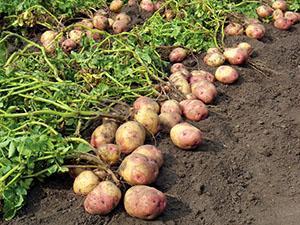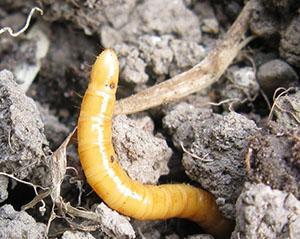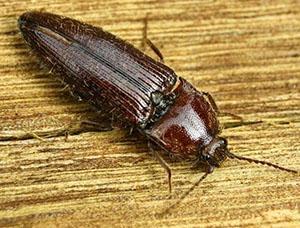How to get rid of a wireworm?
 The main enemy of potato plantings is traditionally the Colorado potato beetle. But if the damage from this pest of potatoes and its larvae on the tops is noticeable with the naked eye, then the losses from the presence of the wireworm are detected only after the harvest is dug.
The main enemy of potato plantings is traditionally the Colorado potato beetle. But if the damage from this pest of potatoes and its larvae on the tops is noticeable with the naked eye, then the losses from the presence of the wireworm are detected only after the harvest is dug.
The danger of the wireworm as a potato pest

 The range of click beetles is extremely extensive, so yellow larvae with a surprisingly dense shell are found everywhere and willingly feed not only on potatoes, but also on the succulent roots of crops such as wheatgrass and bluegrass.
The range of click beetles is extremely extensive, so yellow larvae with a surprisingly dense shell are found everywhere and willingly feed not only on potatoes, but also on the succulent roots of crops such as wheatgrass and bluegrass.
Due to the abundance of juicy food, potato plantings are extremely attractive for larvae. At the same time, the pest actively acts on the beds throughout the growing season, starting from the germination of tubers, ending with the drying of the bushes. But no matter how hard the gardener tries, it is unlikely that it will be possible to completely get rid of the wireworm in the potato field.
Ways to get rid of a wireworm in a potato field
It is only possible to significantly reduce the number of these dangerous insects and with the help of special measures to protect plants from attack by pests. Moreover, the fight against the larvae of the click beetle can be carried out in several directions. This includes:
- tillage and introduction of substances into it that ensure the death of potato pests and prevent their reproduction;
- arrangement of all kinds of traps and baits for wireworms and adult beetles;
- treatment of potatoes before planting with solutions of active substances;
- mechanical digging, loosening the soil on the site and other agrotechnical methods.
Prestige: processing of potatoes before planting
 Measures aimed at protecting the planted tubers from the attack of the wireworm include the treatment of the planting material with active substances such as Prestige. As a result of dressing, seed potatoes after planting lose their attractiveness to the wireworm and other pests, including the Colorado potato beetle, bear and beetle.
Measures aimed at protecting the planted tubers from the attack of the wireworm include the treatment of the planting material with active substances such as Prestige. As a result of dressing, seed potatoes after planting lose their attractiveness to the wireworm and other pests, including the Colorado potato beetle, bear and beetle.
The effect of the drug "Prestige" when processing potatoes, according to the instructions, lasts up to 60 days. Already when the first leaves appear above the garden bed, you can see how Colorado beetles react to the chemical. Adults die quickly, but how do you know if the wireworm is dead?
 Only digging in the bushes and observing the plantings as they grow and bloom will help here. It was found that the number of affected plants during the action of "Prestige" is sharply reduced, and the set young tubers are healthy. But when the 60-day period expires, potato pests rush to planting again.
Only digging in the bushes and observing the plantings as they grow and bloom will help here. It was found that the number of affected plants during the action of "Prestige" is sharply reduced, and the set young tubers are healthy. But when the 60-day period expires, potato pests rush to planting again.
- Since tubers for winter storage are dug up much later than two months later, gardeners cannot do without additional measures to protect the crop.
- But the early varieties of potatoes, which ripen faster than 60 days, are better not to be treated with Prestige.
How do you get rid of the wireworm in the potato field in this case? What plant protection products can you use to get rid of the wireworm.
Methods for getting rid of wireworm in potatoes
 In most cases, the simplest agrotechnical techniques become a serious help:
In most cases, the simplest agrotechnical techniques become a serious help:
- plowing of the site in early spring, when the larvae and adult beetles are still inactive, they easily become prey for birds or die in the sun;
- careful removal of weeds and their roots, which become the habitat of the wireworm and the food of this potato pest;
- summer loosening the soil under the potato bushes allows you to extract the clutch of eggs of the click beetle in the sun destructive for insects;
- digging the site in autumn shortly before the onset of stable frosts helps to extract insects into the air, where the wireworm dies from the cold.
During spring work on the site, fertilizers containing nitrogen and ammonia are applied to the soil, which are extremely unpleasant for the wireworm. In addition, the pest is uncomfortable on soils with low acidity. Experienced gardeners advise adding several granules to the holes when planting superphosphate.
Another effective technique that helps to get rid of the wireworm in potatoes is the introduction of special soil containing predatory nematodes under the tubers when planting. For these microscopic worms, potato pests become tasty prey, and for plants and humans, such organisms are completely safe.
Safe ways to deal with wireworms
 To remove pests from a potato site, all kinds of baits and traps are often used, which are placed along the perimeter of the plantings or located between the ridges.
To remove pests from a potato site, all kinds of baits and traps are often used, which are placed along the perimeter of the plantings or located between the ridges.
- Juicy potato slices are strung on a string, and such garlands are dropped along the ridges to a depth of 5 to 15 cm. The baits are changed after two to three days.
- Every half a meter, several grains of cereals or corn are planted throughout the site. When shoots appear, the succulent roots will surely attract pests.
- Adult beetles and larvae usually congregate under straw, decayed leaves or tops, which can be placed along the border of a potato field.
 When using such baits, it is important to inspect and change them regularly in case of accumulation of dangerous potato pests. As measures to scare away the wireworm, you can use:
When using such baits, it is important to inspect and change them regularly in case of accumulation of dangerous potato pests. As measures to scare away the wireworm, you can use:
- watering the beds with infusions of mother and stepmother, dandelion, celandine or nettle;
- soaking tubers in celandine infusion before planting;
- onion husks, which are placed in the holes when planting tubers;
- marigolds along the perimeter of the site or in the aisles;
- fresh pine or spruce needles dug along the ridges.
 If the area permits, a properly organized crop rotation will help to get rid of the wireworm in the potato field. Soil pests do not affect plants if they are planted in the first year. Therefore, alternating potatoes with plants that are unattractive for wireworms, for example, legumes, spring rape and buckwheat, will help not only preserve the harvest, but also enrich the soil with useful substances.
If the area permits, a properly organized crop rotation will help to get rid of the wireworm in the potato field. Soil pests do not affect plants if they are planted in the first year. Therefore, alternating potatoes with plants that are unattractive for wireworms, for example, legumes, spring rape and buckwheat, will help not only preserve the harvest, but also enrich the soil with useful substances.
After harvesting, it is useful to sow mustard, alfalfa, clover... These crops are absolutely not edible for pests of potatoes, a change in diet will entail the death of insects or their departure from the affected area.
Coincidence or not, but in our area, wireworms are almost never found after many earthworms have bred. For several years after the purchase, the vegetable garden was fertilized only with imported humus, and EM-1 Baikal preparation was used. Wireworm and scab raged on the acquired plot. Moss was used against the scab, which was felled in a swamp and laid out in holes when planting. It helped.
The wireworm did not disappear immediately. Chosen on traps, planted with the addition of Bazudin. But once the earthworms are bred, the wireworm rarely gets caught. At the same time, we use for planting well-greened potatoes, matured before planting in EM-1.And we dug up all the borders from the neighbors and sow phacelia there. Decorative and mass can be used for compost.
I also noticed that if you really choose a wireworm for traps, then it is better in the spring before planting potatoes. In autumn he is well fed, he does not go to bait. It seems to me that while the larvae are small, and this is 2 seasons, someone is eating them. Coincidence or not, but in our area, wireworms are almost never found after many earthworms have bred. For several years after the purchase, the vegetable garden was fertilized only with imported humus, and EM-1 Baikal preparation was used. Wireworm and scab raged on the acquired plot. Moss was used against the scab, which was felled in a swamp and laid out in holes when planting. It helped.
The wireworm did not disappear immediately. Chosen on traps, planted with the addition of Bazudin. But once the earthworms are bred, the wireworm rarely gets caught. At the same time, we use for planting well-greened potatoes, matured before planting in EM-1. And we dug up all the borders from the neighbors and sow phacelia there. Decorative and mass can be used for compost.
I also noticed that if you really choose a wireworm for traps, then it is better in the spring before planting potatoes. In autumn, he is well-fed and does not go to bait. It seems to me that while the larvae are small, and this is 2 seasons, someone is eating them. Rain showers seem to help clear the garden. We only see the wireworm in the third and fourth seasons.
Maybe earthworms are helping to clear the garden. We only see the wireworm in the third and fourth seasons.
I noticed that wireworms are not found in the soil densely populated with earthworms. I think this is due to the fact that worms can destroy the egg clutches of the click beetle. A sharp increase in the population of worms can be achieved by introducing vermicompost into the soil when planting potatoes. 100-150 g for tuber. When digging potatoes, up to 50 worms can be dug under each bush. At the same time, worms destroy pathogenic microorganisms and partially weed seeds. The soil is loose, so the tubers grow evenly and are surprisingly even. The soil retains moisture better and there is sufficient ventilation of the root system. Average yield is about 1000 kg per one hundred square meters. At the same time, soil fertility is constantly increasing. In any case, nine years of planting potatoes on one plot gives an increase in yield. The soil is well structured and does not require excavation.